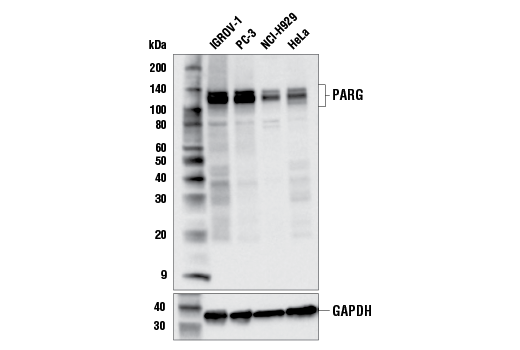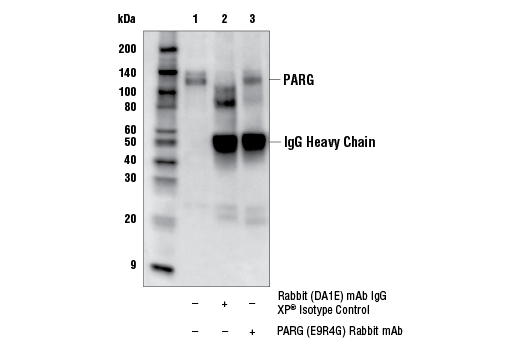WB, IP
H
Endogenous
120-130
Rabbit IgG
#Q86W56
8505
Product Information
Product Usage Information
| Application | Dilution |
|---|---|
| Western Blotting | 1:1000 |
| Immunoprecipitation | 1:100 |
Storage
Specificity / Sensitivity
Species Reactivity:
Human
Source / Purification
Monoclonal antibody is produced by immunizing animals with a synthetic peptide corresponding to residues surrounding Pro179 of human PARG protein.
Background
Poly (ADP-ribose) glycohydrolase (PARG) is an enzyme that hydrolyzes poly (ADP-ribose) (PAR) formed by members of the PAR polymerase (PARP) enzyme family. Poly (ADP)-ribosylation is a post-translational modification that is catalyzed by PARP proteins. This modification involves polymerization of ADP-ribose from NAD+ to target proteins, such as histones and transcription factors, and plays a wide range of biological roles, including the response to DNA damage and transcriptional regulation (1,2). The mammalian PARG enzyme that catalyzes the removal of this modification exists as multiple isoforms. PARG isoforms 1-3 shuttle between the nucleus and cytoplasm and are responsible for most of the PARG activity. The smaller isoforms 4 and 5 reside in the cytoplasm (3-5). Research studies link altered PAR metabolism to inflammatory and autoimmune diseases, as well as neuronal degeneration (6-8). PARG inhibitors that increase PAR levels may sensitize cells to cancer treatments (e.g., cisplatin) and may help in the development of cancer therapies (9).
- Thomas, C. and Tulin, A.V. (2013) Mol Aspects Med 34, 1124-37.
- Li, N. and Chen, J. (2014) Mol Cells 37, 9-16.
- Meyer-Ficca, M.L. et al. (2004) Exp Cell Res 297, 521-32.
- Meyer-Ficca, M.L. et al. (2005) Int J Biochem Cell Biol 37, 920-6.
- Bonicalzi, M.E. et al. (2003) Biol Cell 95, 635-44.
- Cortes, U. et al. (2004) Mol Cell Biol 24, 7163-78.
- Masutani, M. et al. (2005) Cell Mol Life Sci 62, 769-83.
- Ying, W. and Swanson, R.A. (2000) Neuroreport 11, 1385-8.
- Fauzee, N.J. et al. (2010) Pathol Oncol Res 16, 469-78.
Species Reactivity
Species reactivity is determined by testing in at least one approved application (e.g., western blot).
Western Blot Buffer
IMPORTANT: For western blots, incubate membrane with diluted primary antibody in 5% w/v nonfat dry milk, 1X TBS, 0.1% Tween® 20 at 4°C with gentle shaking, overnight.
Applications Key
WB: Western Blotting IP: Immunoprecipitation
Cross-Reactivity Key
H: human M: mouse R: rat Hm: hamster Mk: monkey Vir: virus Mi: mink C: chicken Dm: D. melanogaster X: Xenopus Z: zebrafish B: bovine Dg: dog Pg: pig Sc: S. cerevisiae Ce: C. elegans Hr: horse GP: Guinea Pig Rab: rabbit All: all species expected
Trademarks and Patents
Limited Uses
Except as otherwise expressly agreed in a writing signed by a legally authorized representative of CST, the following terms apply to Products provided by CST, its affiliates or its distributors. Any Customer's terms and conditions that are in addition to, or different from, those contained herein, unless separately accepted in writing by a legally authorized representative of CST, are rejected and are of no force or effect.
Products are labeled with For Research Use Only or a similar labeling statement and have not been approved, cleared, or licensed by the FDA or other regulatory foreign or domestic entity, for any purpose. Customer shall not use any Product for any diagnostic or therapeutic purpose, or otherwise in any manner that conflicts with its labeling statement. Products sold or licensed by CST are provided for Customer as the end-user and solely for research and development uses. Any use of Product for diagnostic, prophylactic or therapeutic purposes, or any purchase of Product for resale (alone or as a component) or other commercial purpose, requires a separate license from CST. Customer shall (a) not sell, license, loan, donate or otherwise transfer or make available any Product to any third party, whether alone or in combination with other materials, or use the Products to manufacture any commercial products, (b) not copy, modify, reverse engineer, decompile, disassemble or otherwise attempt to discover the underlying structure or technology of the Products, or use the Products for the purpose of developing any products or services that would compete with CST products or services, (c) not alter or remove from the Products any trademarks, trade names, logos, patent or copyright notices or markings, (d) use the Products solely in accordance with CST Product Terms of Sale and any applicable documentation, and (e) comply with any license, terms of service or similar agreement with respect to any third party products or services used by Customer in connection with the Products.

